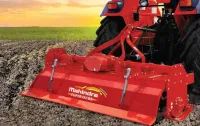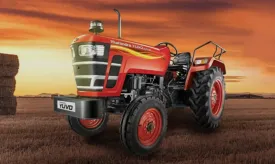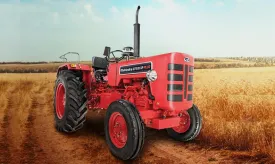Understanding Tractor Steering Systems: A Complete Guide

Everything you need to know about Tractor Steering System
Tractors are the backbone of modern agriculture, making tedious tasks like ploughing, tilling, and hauling heavy loads easier and more efficient. One of the critical components that enable these machines to function smoothly is the steering system. A well-maintained steering system ensures that operators can safely and accurately control the direction of their tractor, which is essential for performance, safety, and efficiency.
In this blog, we will take a detailed look at the different types of tractor steering systems, their components, how they work, and the best practices for maintenance.
Why is tractor steering so important?
Tractor steering is not just about turning the wheels; it plays a vital role in:
- Manoeuvrability: A responsive steering system ensures they can make sharp turns and navigate obstacles with ease in tight spaces, such as farm fields or along narrow paths.
- Safety: A malfunctioning steering system can compromise the stability of the tractor, especially when hauling heavy loads or working on uneven terrain.
- Operator comfort: Good steering systems reduce the effort required to turn the wheel, allowing operators to work longer hours without experiencing fatigue.
Given these functions, understanding how tractor steering works is essential for maintaining both safety and efficiency.
Types of steering systems in tractors
There are several types of steering systems used in modern tractors. Each one is designed to meet specific needs, whether it’s for high-efficiency work, comfort, or ease of use. Let’s explore the most common types:
1. Mechanical (Manual) Steering System
The mechanical system is the most basic form of steering, where the operator turns the steering wheel, and this motion is transmitted directly to the wheels through a series of gears and linkages. The power needed to turn the steering wheel comes solely from the operator's physical effort.
Components:
- Steering wheel: The primary interface for the operator.
- Steering column: Transfers rotational motion from the steering wheel to the rest of the system.
- Steering gearbox: A box with gears that help translate the movement of the steering wheel to the wheels.
- Steering linkage: A series of rods and joints that transfer motion from the gearbox to the wheels.
Advantages:
- Simple design, easy to repair.
- Lower maintenance costs.
- More reliable in harsh conditions.
Disadvantages:
- Requires more physical effort, especially when steering heavy loads or working on rough terrain.
- Less precise steering, making tight turns or handling narrow areas more difficult.
2. Hydraulic Steering System
The hydraulic steering system uses hydraulic fluid and pressure to assist the operator in steering the tractor. When the operator turns the steering wheel, the hydraulic pump generates pressure that moves a steering cylinder, making it easier to turn the wheels. This type of system provides a lot of assistance with minimal physical effort, making steering smoother and more responsive.
Components:
- Hydraulic pump: Provides pressure to move the steering cylinder.
- Steering cylinder: The component that uses hydraulic pressure to turn the wheels.
- Hydraulic fluid reservoir: Stores the hydraulic fluid required for the system.
- Control valve: Regulates the flow of hydraulic fluid to the cylinder based on the operator’s input.
Advantages:
- Reduced physical effort for the operator.
- Easier to steer, especially when turning on rough terrain or handling heavy implements.
- More precise control, especially for sharp turns and tight spaces.
Disadvantages:
- Requires regular maintenance of the hydraulic fluid and pump.
- Higher upfront cost compared to mechanical systems.
- Can become problematic if hydraulic fluid leaks or the system fails.
3. Power Steering System
The power steering system is a combination of hydraulic and mechanical systems, which provides greater ease of steering. The power steering pump generates hydraulic pressure that assists in turning the wheels, allowing the operator to steer with minimal physical effort. This system is commonly found in more modern and higher-end tractors.
Components:
- Power steering pump: Generates hydraulic pressure.
- Steering gear: Translates the motion of the steering wheel into wheel movement.
- Steering cylinder: Works with the hydraulic pressure to steer the tractor.
- Hydraulic fluid: The fluid used to provide the necessary pressure.
Advantages:
- Easier steering with little effort required, making it ideal for long working hours.
- More responsive and precise control, especially in heavy-duty tasks like ploughing or hauling.
- Better comfort for the operator.
Disadvantages:
- More complex and costly than mechanical systems.
- Requires proper maintenance, including checking hydraulic fluid levels and inspecting for leaks.
- Over time, the system may lose effectiveness if the hydraulic components wear out.
4. Four-Wheel Steering System
In a four-wheel steering system, both the front and rear wheels can turn, allowing for a much tighter turning radius. This system is commonly used in tractors designed for tasks that require high manoeuvrability, such as working in narrow fields or confined spaces. The rear wheels move in the same direction as the front wheels when moving forward and in the opposite direction when reversing.
Components:
- Rear Steering Mechanism: Allows the rear wheels to turn in coordination with or opposite the front wheels.
- Control System: Either manual or hydraulic, to manage the turning of both sets of wheels.
- Hydraulic or Mechanical Linkages: Used to transmit the operator’s input to the rear wheels.
Advantages:
- Provides significantly enhanced manoeuvrability.
- Great for tasks in confined spaces, reducing the need for large turning areas.
- Ideal for precise tasks like landscaping or orchard management.
Disadvantages:
- More expensive than standard steering systems.
- Can be more difficult to maintain due to the added complexity.
- Not as commonly used in standard farming applications.
Maintaining a tractor’s steering system
No matter what type of steering system your tractor uses, regular maintenance is key to ensuring its longevity and proper functioning. Here are a few maintenance tips:
1. Check hydraulic fluid levels
For tractors with hydraulic or power steering systems, always check the hydraulic fluid levels regularly. Low fluid levels can cause difficulty in steering and even damage the pump and cylinder. Be sure to use the recommended fluid type for your tractor.
2. Inspect steering linkages
Worn-out or loose linkages can result in poor steering performance. Regularly inspect the steering rods, tie rods, and other components to ensure they are securely connected and free of wear.
3. Examine for leaks
Hydraulic steering systems are particularly prone to leaks. Always inspect hoses, cylinders, and seals for any signs of leakage, as a leak can lead to loss of steering power.
4. Grease moving parts
Lubricating the steering system’s moving parts helps reduce friction and wear. Make sure that the joints, bearings, and linkages are properly greased according to the manufacturer's maintenance schedule.
5. Monitor tyre pressure
Uneven tyre pressure can affect how the tractor steers, causing difficulty when making turns. Ensure the tyres are properly inflated and check them regularly for wear.
6. Regularly inspect the steering wheel and gearbox
Check the steering wheel for any loose connections and ensure the gearbox operates smoothly. Any issue with the steering column or gearbox can result in steering failure.
Conclusion: Choosing the right steering system
Selecting the right steering system for your tractor depends on several factors, including the tractor’s size, the type of work you’ll be doing, and the level of comfort and control you require. Whether you opt for a basic mechanical steering system, a more advanced hydraulic or power steering system, or a highly manoeuvrable four-wheel steering system, it’s important to understand how each system works and how to maintain it for optimal performance.
Regular maintenance is key to ensuring your tractor’s steering system remains responsive, reliable, and safe for years to come. By staying on top of the maintenance and understanding the components of the steering system, you can ensure your tractor remains a high-performing asset in your farming operations.
















